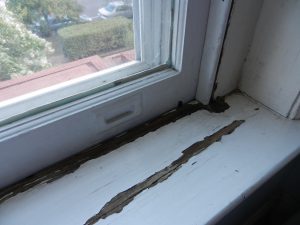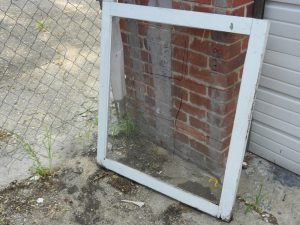Window Restoration – Preservation Cafe
Posted on October 6th, 2013
Neil Mozer, owner of Mozer Works,Inc., shared his passion and expertise for old windows at the Preservation Café, Wednesday September 19, 2013. In a professional 45-minute presentation Mr. Moser, who has been a carpenter/builder for more than 25 years, explained why old windows are important and just what it takes to do a professional restoration.
“I want to debunk the myth that new windows are better,” he noted and added that sophisticated studies had shown that sealed older window plus a good storm window are better than new, high-end replacement windows. Old windows were made from slow-growth trees, rather than the fast-growth used in modern windows. The old windows stand up to the elements much better. “A restored 100 year old window will last another 100 years, so it’s worth the investment,” he said.
In addition, restored old windows preserve the architectural character of the building, look and work as they were intended, and improve energy efficiency.
These improvements do not come cheaply, as demonstrated in an interesting video that detailed the labor-intensive steps needed for a full restoration. A restoration can take 15 to 20 hours and cost between $900 and $2,000 depending on wear and complexity. Mr. Mozer uses very high-end products and a method that slow-cures the treatments and paints needed. He also employs zinc or bronze weather-stripping which decreases drafts and makes the windows operate “with one finger”. The work is done in his facility in Takoma Park.
Mr. Mozer’s passion for the subject was evident when he sadly noted that 12 million window sashes go into landfill every year. He collects old windows. He encouraged CHRS members to call him whenever they find a discarded window. His recycling re-uses the old glass and wood and reduces landfill.
There was a lively question and answer period which included the following opinions:
- Double-glazed windows are not worth the effort and old window frames are not designed to accommodate two panes.
- Storm windows have a 4-5 year return on investment.
- Usually plastic is used to insulate while the windows are in the shop; however, plywood can be used for security.
- He will work with the home-owner to do a ‘partial restoration’ if a full job is unaffordable.
- He will help DYI-ers if he’s able.
- If a window is restored (as opposed to replaced), no permit is needed. However, it is advisable to notify HBR about the project.
For more information, contact Neil Mozer at www.mozerworks.com or 240-398-7688.
PRESERVATION IMPERATIVE: WHY YOUR OLD WINDOWS ARE IMPORTANT
by Neil Mozer June 30,2012
Your old windows are important. It’s as simple as that. It’s not just that they are a building feature and architectural distinction of your home, office, or place of worship. They are inherently valuable and they are under attack. It’s not just a benign neglect due to homeowner or builder owners overwhelmed with yearly maintenance. It’s a billion-dollar industry that is committed to destroying and replacing that enduring architectural feature of your home, work, or church.
According to the Preservation Trades Network, 8 billion dollars is spent each year on replacement windows which equates to 12 million sashes finding their way into local landfills. Literally that enduring feature of our historic heritage is being thrown away and we’re losing not just character but a highly valuable resource.
The good news is your old worn-out wooden (and metal) windows are restorable and it’s definitely worth it. There is a small cadre of dedicated craftspeople that are preservation practitioners who are saving our country’s housing heritage window by window and door by door. In collaboration with local preservation groups many of these practitioners are actively educating local historic communities on the urgency and merit of restoration. These practitioners use the best of today’s technologies for preservation, energy-efficiency and restoration in order to conserve our national building heritage. Interestingly, most recently these trades people have begun the process of developing national standards for the repair and weatherization of old windows (see Preservation trades network.org and the Window Preservation Standards Collaborative).
What makes your old windows far superior to today’s replacements and why promote window restoration? A number of answers come to mind but some salient reasons are: architectural appropriateness, energy efficiency, cost, longevity, promoting local economy, and environmental stewardship.
First, your windows are an architectural statement about the time period when your home was constructed and define the historical context of that style. Second, many studies have proven that those old windows when restored and weatherstripped and protected by a good quality, well-installed storm window are equally performing as a high cost modern replacement window (see National Historic Trust: Brief: window restoration). Third, the cost of window restoration is typically less than a high-end replacement. Fourth, the longevity of your old windows is a testament to their enduring value. Many have lasted over a century and will last another if we maintain them. The old wooden windows were made from old-growth wood, a much more enduring and valuable natural resource than today’s low quality plantation fast-growth lumber. Fifth, window restoration promotes the local economy and a sound economy by sustaining local tradespeople whose service is highly valuable in that it gives decades, if not a century, of return on investment. Lastly, window restoration is environmental stewardship. It signifies a practical approach to preserving our buildings, reducing landfill, conserving energy and resources that would have been spent on replacement. It is akin to building “green” by restoration and underwriting the adage that the greenest building is one that is already built!





